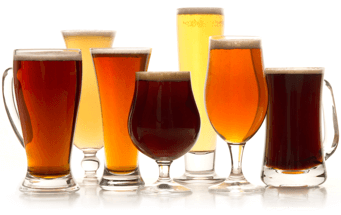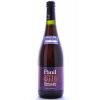Birrificio Torrechiara - Panil Barriquée
-
ABV:
8% -
Serving Temperature:
45–52° F -
Suggested Glassware:
Tulip, Snifter, Flute, or Cab Sauv Glass

We’re pretty pumped to be able to offer up this classic Italian sour ale to our Rare Beer Club members—and especially at such a comparatively low price point. Panil Barriquée is one of the truly impeccable old-school sour imports, and it often retails for around $25 or more per bottle. Aside from this hefty allocation for Rare Beer Club members, this year less than 150 cases of Panil Barriquée will be making it into U.S. distribution beyond what we’ll be sipping.
Panil Barriquée is fermented three times: once in stainless steel, then for 3 months in used Cognac barrels from Bordeaux, and, finally, in the very bottle you now have. It pours a dark, clear amber with garnet hues when held to light. A medium beige head begins thick and fades to an everlasting collar and covering. Expect a vibrant, vinegar-like acidity to strike the nose; one gets the immediate sensation of refreshing tartness. There are some notes of fresh asparagus (don’t worry, in this beer, it’s actually quite nice), and super unripe peaches come to mind, as do SweeTarts candy, oak, faint impressions of smoke, and some pickled spices.
In the flavor, tartness comes through on the palate, but it’s not a puckering tartness, just a nice wake up call to the taste buds. There are some notes of biscuits in the malt backbone, with fruity, vinous qualities (think Chianti), black raspberries, suggestions of cloves, and some spicy plum notes. It’s not surprising that this beer is remarkably wine-like, given its Italian home. A wonderful complexity comes from the cognac-barrel aging, and this imparts, as one might imagine, some very subtle notes of cognac. As it warms, distinct notes of kaffir limes emerge, supplemented by flashes of sour cherry and green apples. Giving a good swirl conjures up notes of musty oranges. It finishes with a complex interplay between bitterness (very faint hops) and sourness, with a wine-like flourish of grapes, acidity and other vinous notes characteristic of malolactic fermentation. Worth noticing are the subtypes of sourness from the acids—both lactic (sour) and acetic (vinegary) notes present. Look for a ghostlike impression of stiff liquor in the way of mild vanilla notes and dry woody oak character. Each batch of this beer is unique—thanks to the wild yeast and the barrel aging, but the quality is extremely consistent—we’ve had many vintages over the years, and all were quite delicious.
Aging is a sure thing with this beer; we’ve sampled bottles that were 3+ years old, and they remain refined, with the acidity mellowing a bit over time. A true to style sour ale, this is an unpasteurized, raw, truly important conservatorium of wild yeast and tradition! Try pairing with other local specialties such as sliced Parmesan cheese or prosciutto, or a garden salad dressed with Balsamic vinegar and olive oil.
By now, you’ve probably heard all about the growth in craft beers in Italy. Years of headline-grabbing news from a country so well known for its wines made this seem like a surprising story. Maybe it’s simply the novelty of Italian beer, something that seemed oxymoronic (so far as U.S. awareness went) up until perhaps a decade ago, especially in the context of a craft beer selection. We think the best part of the story is the fact that it demonstrates quite clearly that craft brewing is alive and well—enough so that wine nations like Italy and France are all experiencing a key beer brewing renaissance and creating some world-class beers. For years, if you were looking for Italian beer in the U.S., you’d be limited to a somewhat bland set of a few pale lagers from a handful of Italian breweries. In recent years, quality has improved dramatically, and brewery numbers have exploded into the hundreds, though access has not. Until very recently, it was quite challenging to get many beer options from Italy in the States.
Nowadays there are more high-quality Italian beers making it to fine beer establishments in the U.S., and using our beer combing skills, we’ve lined up one of the most unique for you, from a brewery that embodies the Italian beer renaissance wholeheartedly. Birrificio Torrechiara (aka Panil Birra Artigianale), located just south of Parma in Northern Italy, demonstrates the change in attitude toward beer in Italy very clearly. Since the 1930s, four generations of the Losi family have produced Lambrusco-style wine at their family-owned winery. In 2001, Lorenzo (Renzo) Losi persuaded his father to let him put his homebrewing talents to work, producing some game-changing beers under the name Panil. Today, Renzo produces more beer under the Panil label than wine. His philosophy is to produce beer naturally, absent any sort of chemical preservatives, pasteurization or filtration, permitting in his beer the most authentic, natural flavors and preventing the “industrialization” that has struck even traditional producers who send their libations to the U.S. market. In short order, Renzo moved from only stainless steel fermentation to the barrel.
Panil Barriquée (from the French word for ‘barrel’) was his first to be fermented in wood, employing cognac barrels. According to Renzo, he is the first Italian brewer in modern times to use barrel fermentation; it’s an important move that brings “new tastes, or rather, the recovery of ancient tastes, [the] woody, winey [notes], are absolutely to be recovered,” according to Renzo. The result is an interpretation of Flemish red ale brewed in the style of Rodenbach that has earned critical acclaim as a truly remarkable beer; it does not employ added sugars to make the beer more palatable for the masses in the U.S. market, staying appropriately dry and keeping things au naturel, avoiding pasteurization which would kill the living, wild yeast in the bottle. Certainly one of the most intriguing takes on Flemish red ale we’ve crossed paths with. Redefining the style? Perhaps. Redefining Italian beer? Definitely.
I touched upon this very briefly in my last column, but wanted to dig a bit deeper into quick and kettle sours, particularly as The Rare Beer Club’s featuring the slow-process Panil Barriquée.
For my latest Trending column in All About Beer Magazine, I tasted through a few dozen sour beers that had been made via quick- or kettle-souring techniques—which are becoming way more popular as of late. The chemistry gist is this: most sour beers (and most beer generally) is fermented after its boiling process, and takes weeks or years to transform available sugars and such into useful things like alcohol, carbon dioxide, and the tart acidity of a sour ale. In quick- or kettle-sour beers, Lactobacillus bacteria (like in Berliner weisse) is added under ideal circumstances before the boiling process, creating a strong vein of lactic acid in a day or two. The subsequent boiling prevents said Lacto from infecting a brewery’s non-sour equipment, which, beyond time savings, also means you don’t have to invest in actual sour equipment.
Don’t get me wrong. I did manage to track down a few quick-sour beers that are worth the effort, including two really nice (if curiously named) releases from Smog City Brewing Co. in Torrance, California: Cuddlebug (with welcome peach and apricot nuances) and Snugglebug (showcasing raspberry and boysenberry additions). Two super-good renderings that manage to work around the core limitation of these beers: the quick-/kettle-sour process will, even if you do everything right, only yield a quite simple, pronounced lemon-custard-y sourness that (as far as I could find) works best when tempered by other ingredients... What I’m getting to is probably some form of the following: Looking to rekindle that love of lambics, and other slow-brewed, complex sour beers? Tasting through a couple dozen kettle sours might help.
Ken Weaver serves as beer editor of All About Beer Magazine, currently in its 37th year and the best-selling beer magazine on U.S. newsstands. Find him on Twitter | Instagram @KenWeaver.

Unmatched Variety by style, brewery & country
Choose from Five different Beer Clubs offering unmatched variety by brewery,
country of origin, and beer style to suit your specific tastes.


